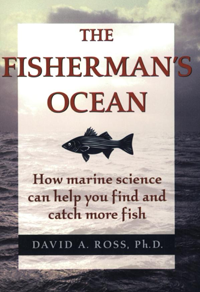The following excerpt is from the book The Fisherman’s Ocean by David A. Ross, Ph.D. Reprinted with permission from Stackpole Books, Mechanicsburg, Pennsylvania.
Fishing Tips Concerning Color
[dropcap]A[/dropcap]nglers probably think color is more of a motivating factor in attracting fish than it actually is. In many instances, a fish’s main use of its color vision is to increase the contrast of prey against different types of backgrounds. Therefore, duplicating the colors of a baitfish in a fly or lure may be less important than simulating the shape of the bait and ensuring good contrast between your fly and the background. Contrast is especially important at low-light levels, such as at dusk and just before dawn. Sometimes, good contrast should be avoided, such as when you’re fishing for bonefish on tidal flats. Here, the conventional fishing wisdom is that you will do best by using a fly that is similar in color to the bottom.
The question of what color fly to use is a subject of considerable debate and controversy among fishermen. Remember that the color red quickly disappears and becomes gray, and then black, within 10 to 20 feet of the surface or from a fish—yet the color may provide good contrast in low-light conditions and many anglers have success using red lures after dark. Most baitfish have some silver in their body, so your fly probably should, too. White is a good color for flies used in deep water. Dark colors, especially blacks, grays, and purples, generally work well at night, since they produce a better silhouette than brighter flies. In general, the brighter the day, the lighter your fly or lure should be; a dark lure may stand out too much on a very bright day. Yellow often is an effective color to use in turbid water. Many anglers favor using green in their flies and lures, because green will hold its color through most fishable depths.
It’s a good idea to use a larger fly or lure when the water is rough, since rough water reduces visibility. Further, a surface or near-surface fly or lure usually presents good contrast against the ocean’s surface. Many of these lures have darkened undersides to increase their contrast. Most fish and baitfish, however, have a light or silver belly, which reduces their contrast and makes them less visible. For this reason, some lure-makers and fly-tiers prefer to imitate the real thing rather than increase contrast. There probably are advantages to both approaches.
Fluorescent colors, especially chartreuse, are visible for considerable distances under water and are used in many successful lures and flies. The effectiveness of these lures is somewhat surprising because fluorescent colors are not found in nature. These colors are best seen when energized by ultraviolet light. Humans do not see ultraviolet light, but some fish do, which may explain why they see fluorescent colors especially well.
As all anglers know only too well, there are times when no color seems to work. On these days try dark, try light, try something in the middle, or try fishing in another area. Ultraviolet light is more common on cloudy days, so fluorescent colors will be more visible at this time, and flies or lures with fluorescent colors should work better under these conditions. Finally, flies or lures with flashy materials or surfaces may be good attractors, but the flash, or too much of it, could also be threatening to the fish you are trying to attract.
In next Wednesday’s Fish Facts Ross explains more about fish SENSES and how to apply them to improve your fish-catch stats.









Join the discussion One Comment